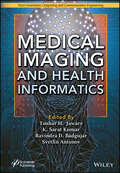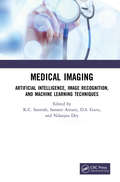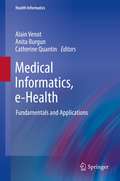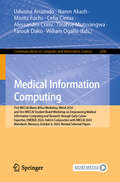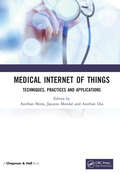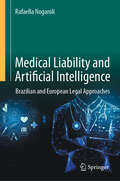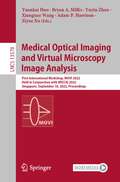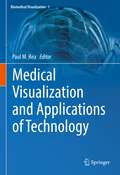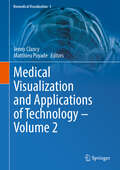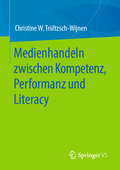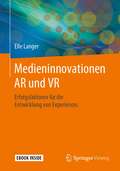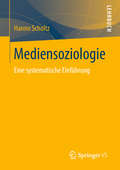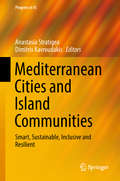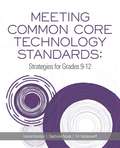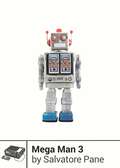- Table View
- List View
Medical Imaging and Computer-Aided Diagnosis: Proceedings of 2022 International Conference on Medical Imaging and Computer-Aided Diagnosis (MICAD 2022) (Lecture Notes in Electrical Engineering #810)
by Han Liu Ruidan Su Yudong Zhang Alejandro F FrangiThis book covers virtually all aspects of image formation in medical imaging, including systems based on ionizing radiation (x-rays, gamma rays) and non-ionizing techniques (ultrasound, optical, thermal, magnetic resonance, and magnetic particle imaging) alike. In addition, it discusses the development and application of computer-aided detection and diagnosis (CAD) systems in medical imaging. Given its coverage, the book provides both a forum and valuable resource for researchers involved in image formation, experimental methods, image performance, segmentation, pattern recognition, feature extraction, classifier design, machine learning / deep learning, radiomics, CAD workstation design, human–computer interaction, databases, and performance evaluation.
Medical Imaging and Health Informatics (Next Generation Computing and Communication Engineering)
by K. Sarat Kumar Svetlin Antonov Tushar H. Jaware Ravindra D. BadgujarMEDICAL IMAGING AND HEALTH INFORMATICS Provides a comprehensive review of artificial intelligence (AI) in medical imaging as well as practical recommendations for the usage of machine learning (ML) and deep learning (DL) techniques for clinical applications. Medical imaging and health informatics is a subfield of science and engineering which applies informatics to medicine and includes the study of design, development, and application of computational innovations to improve healthcare. The health domain has a wide range of challenges that can be addressed using computational approaches; therefore, the use of AI and associated technologies is becoming more common in society and healthcare. Currently, deep learning algorithms are a promising option for automated disease detection with high accuracy. Clinical data analysis employing these deep learning algorithms allows physicians to detect diseases earlier and treat patients more efficiently. Since these technologies have the potential to transform many aspects of patient care, disease detection, disease progression and pharmaceutical organization, approaches such as deep learning algorithms, convolutional neural networks, and image processing techniques are explored in this book. This book also delves into a wide range of image segmentation, classification, registration, computer-aided analysis applications, methodologies, algorithms, platforms, and tools; and gives a holistic approach to the application of AI in healthcare through case studies and innovative applications. It also shows how image processing, machine learning and deep learning techniques can be applied for medical diagnostics in several specific health scenarios such as COVID-19, lung cancer, cardiovascular diseases, breast cancer, liver tumor, bone fractures, etc. Also highlighted are the significant issues and concerns regarding the use of AI in healthcare together with other allied areas, such as the Internet of Things (IoT) and medical informatics, to construct a global multidisciplinary forum. Audience The core audience comprises researchers and industry engineers, scientists, radiologists, healthcare professionals, data scientists who work in health informatics, computer vision and medical image analysis.
Medical Imaging and its Security in Telemedicine Applications (SpringerBriefs in Applied Sciences and Technology)
by Rohit Thanki Surekha BorraThis book introduces medical imaging, its security requirements, and various security mechanisms using data hiding approaches. The book in particular provides medical data hiding techniques using various advanced image transforms and encryption methods. The book focuses on two types of data hiding techniques: steganography and watermarking for medical images. The authors show how these techniques are used for security and integrity verification of medical images and designed for various types of medical images such as grayscale image and color image. The implementation of techniques are done using discrete cosine transform (DCT), discrete wavelet transform (DWT), singular value decomposition (SVD), redundant DWT (RDWT), fast discrete curvelet transform (FDCuT), finite ridgelet transform (FRT) and non-subsampled contourlet transform (NSCT). The results of these techniques are also demonstrated after description of each technique. Finally, some future research directions are provided for security of medical images in telemedicine application.
Medical Imaging: Artificial Intelligence, Image Recognition, and Machine Learning Techniques (Advances in Intelligent Systems and Computing #651)
by Nilanjan Dey K. C. Santosh D. S. Guru Sameer AntaniThe book discusses varied topics pertaining to advanced or up-to-date techniques in medical imaging using artificial intelligence (AI), image recognition (IR) and machine learning (ML) algorithms/techniques. Further, coverage includes analysis of chest radiographs (chest x-rays) via stacked generalization models, TB type detection using slice separation approach, brain tumor image segmentation via deep learning, mammogram mass separation, epileptic seizures, breast ultrasound images, knee joint x-ray images, bone fracture detection and labeling, and diabetic retinopathy. It also reviews 3D imaging in biomedical applications and pathological medical imaging.
Medical Informatics, e-Health: Fundamentals and Applications
by Catherine Quantin Alain Venot Anita BurgunThanks to this book, it will be possible for readers to understand Health Informatics as a young scientific discipline compared to general computing, bioinformatics, bioengineering and medicine. The book introduces major journals in the field, major conferences, the national and international structures of the discipline, and the major sources of funding. Readers will find in the book the fundamentals of the large terminological resources in Health which are very difficult to understand (thesauri, classifications, ontology...). In terms of application, the book will include the main features of the software developed in the major structures of Health (hospital information systems, computerization of medical and dental practice, and pharmacies) with applications in various countries. The book will consider the ongoing revolution linked to the development of telemedicine and, more generally, to e-Health, smart home and disability help. Human factors, development of user interfaces will be considered.
Medical Information Computing: First MICCAI Meets Africa Workshop, MImA 2024, and First MICCAI Student Board Workshop on Empowering Medical Information Computing and Research through Early-Career Expertise, EMERGE 2024, Held in Conjunction with MICCAI 2024, Marrakesh, Morocco, October 6, 2024, Revised Selected Papers (Communications in Computer and Information Science #2240)
by Alessandro Crimi Celia Cintas Udunna Anazodo Naren Akash Moritz Fuchs Tinahse Mutsvangwa Farouk Dako Willam OgalloThis book presents a series of revised papers selected from the First MICCAI Meets Africa Workshop, MImA 2024, and First MICCAI Workshop on Empowering Medical Information Computing and Research through Early-Career Expertise, EMERGE 2024, which was held in Marrakesh, Morocco, during October 6, 2024. MImA 2024 accepted 21 full papers from 45 submissions; for EMERGE 8 papers are included from 9 submissions. They describe cutting-edge research from computational scientists and clinical researchers working on a variety of medical image computing challenges relevant to the African and broader global contexts, as well as emerging techniques for image computing methods tailored to low-resource settings.
Medical Information Systems Ethics
by Jérôme BérangerThe exponential digitization of medical data has led to a transformation of the practice of medicine. This change notably raises a new complexity of issues surrounding health IT. The proper use of these communication tools, such as telemedicine, e-health, m-health the big medical data, should improve the quality of monitoring and care of patients for an information system to "human face". Faced with these challenges, the author analyses in an ethical angle the patient-physician relationship, sharing, transmission and storage of medical information, setting pins to an ethic for the digitization of medical information. Drawing on good practice recommendations closely associated with values, this model is developing tools for reflection and present the keys to understanding the decision-making issues that reflect both the technological constraints and the complex nature of human reality in medicine .
Medical Internet of Things: Techniques, Practices and Applications
by Anirban MitraIn recent years, the Medical Internet of Things (MIoT) has emerged as one of the most helpful technological gifts to mankind. With the incredible development in data science, big data technologies, IoT and embedded systems, it is now possible to collect a huge amount of sensitive and personal data, compile it and store it through cloud or edge computing techniques. However, important concerns remain about security and privacy, the preservation of sensitive and personal data, and the efficient transfer, storage and processing of MIoT-based data. Medical Internet of Things: Techniques, Practices and Applications is an attempt to explore new ideas and novel techniques in the area of MIoT. The book is composed of fifteen chapters discussing basic concepts, issues, challenges, case studies and applications in MIoT. This book offers novel advances and applications of MIoT in a precise and clear manner to the research community to achieve in-depth knowledge in the field. This book will help those interested in the field as well as researchers to gain insight into different concepts and their importance in multifaceted applications of real life. This has been done to make the book more flexible and to stimulate further interest in the topic. Features: A systematic overview of concepts in Medical Internet of Things (MIoT) is included. Recent research and some pointers on future advancements in MIoT are discussed. Examples and case studies are included. It is written in an easy-to-understand style with the help of numerous figures and datasets. This book serves as a reference book for scientific investigators who are interested in working on MIoT, as well as researchers developing methodology in this field. It may also be used as a textbook for postgraduate-level courses in computer science or information technology.
Medical Liability and Artificial Intelligence: Brazilian and European Legal Approaches
by Rafaella NogaroliThis book offers an in-depth examination of the critical intersection between medical practice and artificial intelligence, analysing the benefits, risks, and complex challenges that AI introduces into the doctor–patient relationship. It provides comprehensive insights into the reconceptualisation of medical duties, addressing both their ethical imperatives and their binding legal force. With a particular focus on medical malpractice and medico-legal duties, the book examines the ethical principles underpinning the use of artificial intelligence in medicine and their correlation with legal obligations. It further provides a general overview of the regulatory framework governing AI within the European Union, drawing comparisons with existing legal concepts under the Brazilian legal system. This is the first book worldwide to focus exclusively on the analysis of medical liability within the context of artificial intelligence. Originally published in Portuguese, it is now presented in an expanded and fully translated English edition. Aimed at both academic institutions and legal and healthcare practitioners, this research monograph addresses a notable gap in the existing literature. It serves as a valuable resource for scholars, legal professionals, and medical practitioners seeking a comprehensive understanding of the intersection between AI and medical malpractice. Through its in-depth legal analysis and practical case studies, the book offers a focused examination of medical malpractice and civil liability arising from the use of AI systems, enhancing its relevance to a wide-ranging audience. The book encompasses a broad range of topics relating to medical liability in the context of AI systems, adopting a practical approach that renders its content applicable across different legal jurisdictions. The foundational concepts of Medical Law and artificial intelligence it presents are relevant to multiple national frameworks, thereby enhancing its accessibility. This adaptability and universal applicability position the work as a valuable resource for international audiences, offering insights and guidance that may be effectively applied in diverse legal and healthcare contexts.
Medical Optical Imaging and Virtual Microscopy Image Analysis: First International Workshop, MOVI 2022, Held in Conjunction with MICCAI 2022, Singapore, September 18, 2022, Proceedings (Lecture Notes in Computer Science #13578)
by Ziyue Xu Yuankai Huo Bryan A. Millis Yuyin Zhou Xiangxue Wang Adam P. HarrisonThis book constitutes the refereed proceedings of the 1st International Workshop on Medical Optical Imaging and Virtual Microscopy Image Analysis, MOVI 2022, held in conjunction with the 25th International Conference on Medical Imaging and Computer-Assisted Intervention, MICCAI 2022, in Singapore, Singapore, in September 2022. The 18 papers presented at MOVI 2022 were carefully reviewed and selected from 25 submissions. The objective of the MOVI workshop is to promote novel scalable and resource-efficient medical image analysis algorithms for high-dimensional image data analy-sis, from optical imaging to virtual microscopy.
Medical Optical Imaging and Virtual Microscopy Image Analysis: Second International Workshop, MOVI 2024, Held in Conjunction with MICCAI 2024, Marrakesh, Morocco, October 10, 2024, Proceedings (Lecture Notes in Computer Science #15371)
by Xiao Wang Yuankai Huo Bryan A. Millis Yuyin Zhou Khaled Younis Yucheng TangThis book constitutes the refereed proceedings of the Second International Workshop on Medical Optical Imaging and Virtual Microscopy Image Analysis, MOVI 2024, held in conjunction with the 26th International Conference on Medical Imaging and Computer-Assisted Intervention, MICCAI 2024, in Marrakesh, Morocco, in October 2024. The 21 regular papers presented at MOVI 2024 were carefully reviewed and selected from 29 submissions. They are grouped into these two topical sections: Medical Optical Imaging and Virtual Microscopy Image Analysis and Kidney Pathology Image segmentation (KPIs) Challenge.
Medical Ultrasound, and Preterm, Perinatal and Paediatric Image Analysis: First International Workshop, ASMUS 2020, and 5th International Workshop, PIPPI 2020, Held in Conjunction with MICCAI 2020, Lima, Peru, October 4-8, 2020, Proceedings (Lecture Notes in Computer Science #12437)
by Stephen Aylward Andrew Melbourne Roxane Licandro Jana Hutter Esra Abaci Turk J. Alison Noble Yipeng Hu Jordina Torrents BarrenaThis book constitutes the proceedings of the First International Workshop on Advances in Simplifying Medical UltraSound, ASMUS 2020, and the 5th International Workshop on Perinatal, Preterm and Paediatric Image Analysis, PIPPI 2020, held in conjunction with MICCAI 2020, the 23rd International Conference on Medical Image Computing and Computer-Assisted Intervention. The conference was planned to take place in Lima, Peru, but changed to an online event due to the Coronavirus pandemic. For ASMUS 2020, 19 contributions were accepted from 26 submissions; the 14 contributions from the PIPPI workshop were carefully reviewed and selected from 21 submissions. The papers were organized in topical sections named: diagnosis and measurement; segmentation, captioning and enhancement; localisation and guidance; robotics and skill assessment, and PIPPI 2020.
Medical Visualization and Applications of Technology (Biomedical Visualization #1)
by Paul M. ReaThis edited book explores the use of technology to enable us to visualize the life sciences in a more meaningful and engaging way. It will enable those interested in visualization techniques to gain a better understanding of the applications that can be used in visualization, imaging and analysis, education, engagement and training. The reader will also be able to learn about the use of visualization techniques and technologies for the historical and forensic settings. The reader will be able to explore the utilization of technologies from a number of fields to enable an engaging and meaningful visual representation of the biomedical sciences. We have something for a diverse and inclusive audience ranging from healthcare, patient education, animal health and disease and pedagogies around the use of technologies in these related fields. The first four chapters cover healthcare and detail how technology can be used to illustrate emergency surgical access to the airway, pressure sores, robotic surgery in partial nephrectomy, and respiratory viruses. The last six chapters in the education section cover augmented reality and learning neuroanatomy, historical artefacts, virtual reality in canine anatomy, holograms to educate children in cardiothoracic anatomy, 3D models of cetaceans, and the impact of the pandemic on digital anatomical educational resources.
Medical Visualization and Applications of Technology ‒ Volume 2 (Biomedical Visualization #5)
by Jenny Clancy Matthieu PoyadeThis edited volume encompasses chapters on novel and innovative research in the applications of leading digital technologies in an accessible and engaging way. By utilising cutting edge and ever progressive technology in visualization, it will enhance our understanding and application in our everyday lives. This volume shows how we can use Extended Reality, 3D animations and serious games to benefit the learner, educator, clinician, patient, parent and carer. Visualization techniques like Virtual, Augmented and Mixed Reality and show how they can be utilised to improve training and understanding of anatomy, surgery, and clinical assessment. This is covered specifically for emergency practitioners in enhancing their understanding of ECG’s for potential myocardial infarction by using augmented reality. From a translational medicine perspective and pre-operative pediatric surgical planning, the benefits of augmented reality are examined as to what might be found intra-operatively from imaging techniques. Educational applications of digital technologies using serious games and Extended Reality are examined. We show how Mixed Reality can aid understanding in cellular anatomy for our learners and researchers alike. We also show how serious games can have applications in diverse areas like parasite infections and neuroanatomy education and training. Finally, from a clinical perspective, the use of 3D animations and their applications is discussed for vertebral fractures and increasing parent/carer awareness through interactive applications. Also, the use of 3D animations in cerebral magnetic resonance angiography for global education highlights the great benefits of these tools and technologies. There is something for the researcher, clinician, educator, patient, and carer as we explore novel technologies. These are applied locally, nationally and globally as we advance our understanding of the world changing influence that digital technologies have on our day-to-day life.
Medien- und Internetmanagement
by Bernd W. WirtzDer Medien- und Kommunikationssektor hat sich zu einem zentralen Wirtschaftsbereich in der Informationsgesellschaft entwickelt. Dieses Buch behandelt das Medienmanagement für die elektronischen und printbasierten Medien. Vor dem Hintergrund der Branchenkonvergenz werden die grundlegenden Entwicklungen, Wertschöpfungsstrukturen, Geschäftsmodelle und Wettbewerbsstrategien im Rahmen einer integrierten Managementbetrachtung dargestellt. Darüber hinaus werden neuere Entwicklungen bei Internetmedien behandelt.
Medienhandeln zwischen Kompetenz, Performanz und Literacy
by Christine W. Trültzsch-WijnenDas Buch diskutiert die soziale und individuelle Bedingtheit von Medienkompetenz. Im Mittelpunkt steht die Frage, wie sich das Medienhandeln von Individuen im Hinblick auf deren Medienkompetenz, im Sinne eines sicheren und selbstbestimmten Handelns im Umgang mit Medien, erklären und beurteilen lässt. Dies setzt eine Betrachtung des Medienhandelns vor dem Hintergrund der Beziehungen zwischen der Kompetenz zu Handeln, als Summe von Fähigkeiten, Fertigkeiten und Wissen sowie der kognitiven Beherrschung von Regeln des Verhaltens (moralische Regeln, rechtliche Regeln sowie Regeln der Klugheit), und der Performanz, als tatsächliches Handeln eines Individuums, voraus. Dabei wird auf theoretischer Ebene der Frage nach der sozialen Determinierung eines selbstbestimmten Handelns im Umgang mit Medien einschließlich dafür erforderlicher Fähigkeiten, Fertigkeiten sowie des damit verbundenen Wissens nachgegangen. Außerdem wird das Verhältnis des deutschsprachigen Medienkompetenzdiskurses zum internationalen Diskurs über media literacy erläutert. Es werden Gemeinsamkeiten und Unterschiede herausgearbeitet und Potentiale für eine gegenseitige Befruchtung beider Perspektiven aufgezeigt. Darüber hinaus wird die empirische Relevanz und Anwendbarkeit dieser theoretischen Überlegungen anhand zweier Studien illustriert.
Medieninnovationen AR und VR: Erfolgsfaktoren für die Entwicklung von Experiences
by Elle LangerAugmented und Virtual Reality sind Medieninnovationen mit spezifischen Merkmalen. Sie erzeugen beim Nutzer eine Immersion, da der Nutzer in das Medium und seine 360° Umgebung hineintaucht. Um erfolgreich Inhalte und Anwendungen für AR und VR zu entwickeln, müssen psychologische Wirkungsweisen, die Besonderheiten der 360° Umgebung, die Geschichte und die Art der Mediennutzug mit den Bedürfnissen und Erlebnissen des Nutzers abgestimmt werden. Contentproduzenten stellt das vor neuartige Herausforderungen bei der Contententwicklung, der Methodenwahl, der Teamarbeit und dem gesamten Herstellungsprozess von AR und VR Experiences.Das Buch führt den Leser in die Merkmale der immersiven Medien ein und bietet ihm wissenschaftliche Belege und praxisrelevante Tipps, die ihm helfen, hochwertige und nutzerzentrierte Inhalte für die Immersiven Medien zu produzieren. Die wissenschaftlich hergeleiteten Erfolgsfaktoren in Form von Checklisten sind ein Leitfaden und eine ideale Grundlage, um den Herstellungsprozess zu standardisieren und die eigenen Projekte weiterzuentwickeln.
Mediensoziologie: Eine systematische Einführung
by Hanno ScholtzWas haben Veränderungen in Gesellschaften und ihren Medien miteinander zu tun? Wo tragen Medien zu gesellschaftlichen Problemen bei und wo können sie diese lösen helfen? Wie wird darüber in der Wissenschaft diskutiert, und wie hängen diese Diskussionen zusammen? Ausgehend von Individuen mit ihren Wahrnehmungen und Handlungsentscheidungen, den von ihnen begründeten Institutionen, und einer knappen Definition von Medien bietet dieser Einführungsband in die Mediensoziologie eine systematische Darstellung, die einen Überblick ermöglicht und Probleme und im Fach geführte Diskussionen einordnen lässt.
Medieval Manuscripts in the Digital Age (Digital Research in the Arts and Humanities)
by Benjamin AlbrittonMedieval Manuscripts in the Digital Age explores one major manuscript repository’s digital presence and poses timely questions about studying books from a temporal and spatial distance via the online environment. Through contributions from a large group of distinguished international scholars, the volume assesses the impact of being able to access and interpret these early manuscripts in new ways. The focus on Parker on the Web, a world-class digital repository of diverse medieval manuscripts, comes as that site made its contents Open Access. Exploring the uses of digital representations of medieval texts and their contexts, contributors consider manuscripts from multiple perspectives including production, materiality, and reception. In addition, the volume explicates new interdisciplinary frameworks of analysis for the study of the relationship between texts and their physical contexts, while centring on an appreciation of the opportunities and challenges effected by the digital representation of a tangible object. Approaches extend from the codicological, palaeographical, linguistic, and cultural to considerations of reader reception, image production, and the implications of new technologies for future discoveries. Medieval Manuscripts in the Digital Age advances the debate in manuscript studies about the role of digital and computational sources and tools. As such, the book will appeal to scholars and students working in the disciplines of Digital Humanities, Medieval Studies, Literary Studies, Library and Information Science, and Book History.
Mediterranean Cities and Island Communities: Smart, Sustainable, Inclusive and Resilient (Progress in IS)
by Anastasia Stratigea Dimitris KavroudakisThis book addresses the issue of smart and sustainable development in the Mediterranean (MED) region, a distinct part of the world, full of challenges and risks but also opportunities. Above all, the book focuses on smartening up small and medium-sized cities and insular communities, taking into account their geographical peculiarities, the pattern of MED urban settlements and the abundance of island complexes in the MED Basin. Taking for granted that sustainability in the MED is the overarching policy goal that needs to be served, the book explores different aspects of smartness in support of this goal’s achievement. In this respect, evidence from concrete smart developments adopted by forerunners in the MED region is collected and analyzed; coupled with experiences gathered from successful, non-MED, examples of smart efforts in European countries. More specifically, current research and empirical results from MED urban environments are discussed, as well as findings from or concerning other parts of the world, which are of relevance to the MED region. The book’s primary goal is to enable policymakers, planners and decision-making bodies to recognize the challenges and options available; and make to more informed policy decisions towards smart, sustainable, inclusive and resilient urban and regional futures in the MED.
Mediterranean Forum – Data Science Conference: First International Conference, MeFDATA 2020, Sarajevo, Bosnia and Herzegovina, October 24, 2020, Revised Selected Papers (Communications in Computer and Information Science #1343)
by Mehmed Kantardzic Jasminka Hasic TelalovicThis book constitutes selected and revised papers from the First Mediterranean Forum - Data Science Conference, MeFDATA 2020, held in Sarajevo, Bosnia and Herzegovina, in October 2020. The 11 papers presented were carefully reviewed and selected from the 26 qualified submissions. The papers are organized in the topical sections on human behaviour and pandemic; applications in medicine; industrial applications; natural language processing.
Medium Hot: Images in The Age of Heat
by Hito SteyerlWHAT IS THE FUTURE OF THE IMAGE IN THE AGE OF CLIMATE CHANGE AND ARTIFICIAL INTELLIGENCE?Hito Steyerl is one of the most celebrated artists of our time. Her work, both as an artist and a writer, has consistently challenged the political boundaries between art and technology. In this new collection of groundbreaking essays, she explores how AI, the use of large language models and the algorithmic creation of imagery transform our understanding of the world. She argues that such practices cannot be divorced from the economic and political conditions of the times.Medium Hot is a collection of scintillating meditations on the limits of art and technology: the essential handbook for the present conjuncture. The pieces here probe the manufacture and distribution of images in the age of AI and climate change. She asks whether art can be made not only by machines but for machines. She argues against the production of images that heat up the planet, disfranchise workers and fuel the arms trade, and questions whether such creations can even be called art.In an era of such rapid change, Steyerl does vital work investigating whether machine learning will infiltrate every aspect of our lives and what that means for the future.
Medizininformatik: Ein Kompendium für Studium und Praxis
by Martin DugasDas sich dynamisch entwickelnde Gebiet der Medizininformatik mit dem Ziel der Digitalisierung der Medizin wird im vorliegenden Buch kompakt dargestellt. Es soll einen umfassenden und verst#65533;ndlichen Einstieg in die Medizininformatik erm#65533;glichen. Im ersten Kapitel werden Grundbegriffe aus der Medizin erl#65533;utert, die f#65533;r Leser mit vorwiegend technischem Hintergrund wichtig sind. Das zweite Kapitel ist gedacht f#65533;r Leser mit medizinisch-biologischer Ausbildung und erl#65533;utert wichtige Informatikbegriffe. Im Anschluss daran werden die wichtigsten Teilgebiete der Medizininformatik vorgestellt, unter besonderer Ber#65533;cksichtigung des "Lernzielkatalogs Medizinische Informatik f#65533;r Studierende der Humanmedizin".
Meeting Common Core Technology Standards: Strategies For Grades 9-12 (First Edition)
by Valerie Morrison Stephanie Novak Tim Vanderwerff<P>Have you ever wished you had an instructional coach at your side to help align your curriculum with the tech-related indicators found in the Common Core State Standards (CCSS)? <P>You're not alone. <P>Nearly all U.S. states have adopted Common Core, and teachers across the country are redesigning their lessons to meet the standards, including the edtech component. In this book (the fourth in a four-book series), you'll learn how to shift your instructional practice and integrate technology standards found within Common Core into high school curriculum. <P>This book: addresses issues that digital age able bodied students face and examines the importance of tailoring their learning experiences using technology; discusses technology needed to teach CCSS and shows how to address roadblocks to incorporating technology; explains how the CCSS are organized and offers a deep dive into the standards specific to grades 9-12; includes classroom-tested lesson ideas mapped to tech-related CCSS and ISTE Standards; and shares resources (apps, software and websites) that can be used in meeting CCSS.
Mega Man 3 (Boss Fight Books)
by Salvatore PaneCapcom's Keiji Inafune followed the unexpected success of Mega Man 2 with a kitchen sink sequel that included eight new robot masters, a canine companion, a mysterious new frenemy, and a melancholy tone that runs through the game from its soft opening notes. Mega Man 3 was the biggest, messiest, and most ambitious Mega Man game yet. But why do we hunger for twitchy, difficult platformers like Mega Man 3 decades later when the developers, the franchise, and the Blue Bomber himself have all moved on? Investigating the development of the Mega Man series alongside the rise of video game emulation, the YouTube retrogaming scene, and the soaring price of NES carts, novelist Salvatore Pane takes a close and compelling look at the lost power-ups of our youth that we collect in our attempts to become complete again.

